Preparation and Lithium-Ion Capacitance Performance of Nitrogen and Sulfur Co-Doped Carbon Nanosheets with Limited Space via the Vermiculite Template Method
Abstract
:1. Introduction
2. Results and Discussion
2.1. Microstructure and Composition
2.2. Electrochemical Performance
3. Materials and Methods
3.1. Preparation of Materials
- The vermiculite raw mineral water was cleaned and dried after filtering impurities such as soil and sand. Subsequently, the dried vermiculite was calcined in a muffle furnace at 1000 °C for 1 min, and the thermally expanded vermiculite obtained via sieving was recorded as EV.
- In total, 10 g of methylene blue (C16H18ClN3S·3H2O) was dispersed in 100 mL of deionized water. Subsequently, the expanded vermiculite was added to the mixed solution. After ultrasonic treatment for 3 h and vacuum immersion for 12 h, the methylene blue molecules were fully adsorbed to the surface or entered the gap of the expanded vermiculite layer. After filtration and drying, the intercalation compound was recorded as MB-EVMT.
- The intercalation compounds were carbonized at 600 °C, 700 °C, 800 °C, and 900 °C for 2 h in N2 atmosphere and cooled to room temperature. The product prepared via carbonization at 600 °C was labeled as MB-CNS-600, and the products prepared at different temperatures were labeled with the same method.
- MB-CNS-600, MB-CNS-700, MB-CNS-800, and MB-CNS-900 were soaked in hydrofluoric acid (HF) and concentrated hydrochloric acid (HCl) to remove the template, washed with deionized water to neutral, suction filtrated, and dried in a drying cabinet. Finally, we obtained CNS-600, CNS-700, CNS-800, and CNS-900.
- Pure methylene blue without a vermiculite template was carbonized at 700 °C for 2 h in a N2 atmosphere. The product obtained via cooling and sieving was marked as MB-700.
3.2. Materials Characterization
3.3. Electrochemical Measurements
4. Conclusions
Author Contributions
Funding
Institutional Review Board Statement
Informed Consent Statement
Data Availability Statement
Conflicts of Interest
References
- Xing, J.; Sun, P.; Shi, F. Application Progress of Co-MOFs Materials in Supercapacitors. J. Mater. Sci. Eng. 2022, 40, 160–170. [Google Scholar]
- Raić, M.; Mikac, L.; Marić, I.; Štefanić, G.; Škrabić, M.; Gotić, M.; Ivanda, M. Nanostructured silicon as potential anode material for Li-ion batteries. Molecules 2020, 25, 891. [Google Scholar] [CrossRef] [PubMed]
- Ivana, H.; Philipp, A.; Cao, J.; Mai, L. Batteries & supercaps: Beyond lithium-ion batteries. Batter. Supercaps 2021, 4, 1036–1038. [Google Scholar]
- Qi, J.; Guo, R.; Zhao, F.; Li, W.Y.; Yao, W.Q. Tailoring the lattice structure of manganese oxides underelectric field and improving the supercapacity of them. Mater. Sci. Eng. B 2017, 225, 134–139. [Google Scholar] [CrossRef]
- Han, C.; Li, H.; Shi, R.; Xu, L.; Li, J.; Kang, F.; Li, B. Nanostructured anode materials for non-aqueous lithium-ion hybrid capacitors. Energy Environ. Mater. 2018, 1, 75–87. [Google Scholar] [CrossRef]
- Li, Z.; Zhang, X.; Cheng, H.; Liu, J.; Shao, M.; Wei, M.; Evans, D.G.; Zhang, H.; Duan, X. Confined synthesis of 2D nanostructured materials toward electrocatalysis. Adv. Energy Mater. 2020, 10, 1900486. [Google Scholar] [CrossRef]
- He, Y.; Zhuang, X.; Lei, C.; Lei, L.; Hou, Y.; Mai, Y.; Feng, X. Porous carbon nanosheets: Synthetic strategies and electrochemical energy related applications. Nano Today 2019, 24, 103–119. [Google Scholar] [CrossRef]
- Li, Z.; Zhang, L.; Chen, X.; Li, B.; Wang, H.; Li, Q. Three-dimensional graphene-like porous carbon nanosheets derived from molecular precursor for high-perfor-mance supercapacitor application. Electrochim. Acta 2019, 296, 8–17. [Google Scholar] [CrossRef]
- Zardkhoshoui, A.M.; Ameri, B.; Davarani, S.S.H. α-MnS@Co3S4 hollow nanospheres assembled from nanosheets for hybrid super-capacitors. Chem. Eng. J. 2021, 422, 129953. [Google Scholar] [CrossRef]
- Guo, X.; Liu, G.; Yue, S.; He, J.; Wang, L. Hydroxyl-rich nanoporous carbon na-nosheets synthesized by a one-pot method and their application in the in situpreparation of well-dispersed Ag nanoparticles. RSC Adv. 2015, 5, 96062–96066. [Google Scholar] [CrossRef]
- Fan, Z.; Liu, Y.; Yan, J.; Ning, G.; Wang, Q.; Wei, T.; Zhi, L.; Wei, F. Template-directed synthesis of pillared-porous carbon nanosheet architectures: High-performance electrode materials for supercapacitors. Adv. Energy Mater. 2012, 2, 419–424. [Google Scholar] [CrossRef]
- Chen, L.; Wang, Z.; He, C.; Zhao, N.; Shi, C.; Liu, E.; Li, J. Porous graphitic carbon nanosheets as a high-rate anode material for lithium-ion batteries. ACS Appl. Mater. Interfaces 2013, 5, 9537–9545. [Google Scholar] [CrossRef] [PubMed]
- Jang, B.; Park, M.; Chae, O.B.; Park, S.; Kim, Y.; Oh, S.M.; Piao, Y.; Hyeon, T. Direct synthesis of self-assembled ferrite/carbon hybrid nanosheets for high performance lithium-ion battery anodes. J. Am. Chem. Soc. 2012, 134, 15010–15015. [Google Scholar] [CrossRef] [PubMed]
- Yu, H.; Shang, L.; Bian, T.; Shi, R.; Waterhouse, G.I.; Zhao, Y.; Zhou, C.; Wu, L.Z.; Tung, C.H.; Zhang, T. Nitrogen-doped porous carbon nanosheets templated from g-C3N4 as metal-free electrocatalysts for efficient oxygen reduction reaction. Adv. Mater. 2016, 28, 5080–5086. [Google Scholar] [CrossRef] [PubMed]
- Qu, K.; Zheng, Y.; Dai, S.; Qiao, S.Z. Graphene oxide-polydopamine derived N, S-codoped carbon nanosheets as superior bifunctional electrocatalysts for oxygen reduction and evolution. Nano Energy 2016, 19, 373–381. [Google Scholar] [CrossRef]
- Wu, N.; Wu, L.; Liao, L.; Lv, G. Organic intercalation of structure modified vermiculite. J. Colloid Interface Sci. 2015, 457, 264–271. [Google Scholar] [CrossRef] [PubMed]
- İşçi, S. Intercalation of vermiculite in presence of surfactants. Appl. Clay Sci. 2017, 146, 7–13. [Google Scholar] [CrossRef]
- Ferronato, C.; Silva, B.; Costa, F.; Tavares, T. Vermiculite bio-barriers for Cu and Zn remediation: An eco-friendly approach for freshwater and sediments protection. Int. J. Environ. Sci. Technol. 2016, 13, 1219–1228. [Google Scholar] [CrossRef]
- Qi, X.; Wu, S.; Wang, Z.; Zuo, Z.; Dong, R. Seasonal and daily emissions of methane and carbon dioxide from a pig wastewater storage system and the use of artificial vermiculite crusts. Biosyst. Eng. 2015, 131, 15–22. [Google Scholar] [CrossRef]
- Liu, Y.; Zheng, Y.; Wang, A. Enhanced adsorption of Methylene Blue from aqueous solution by chitosan-g-poly (acrylic acid)/vermiculite hydrogel composites. J. Environ. Sci. 2010, 22, 486–493. [Google Scholar] [CrossRef]
- Ning, G.; Xu, C.; Cao, Y.; Zhu, X.; Jiang, Z.; Fan, Z.; Qian, W.; Weid, F.; Gao, J. Chemical vapor deposition derived flexible graphene paper and its application as high performance anodes for lithium rechargeable batteries. J. Mater. Chem. A 2013, 1, 408–414. [Google Scholar] [CrossRef]
- He, H.; Huang, D.; Tang, Y.; Wang, Q.; Ji, X.; Wang, H.; Guo, Z. Tuning nitrogen species in three-dimensional porous carbon via phosphorus doping for ultra-fast potassium storage. Nano Energy 2019, 57, 728–736. [Google Scholar] [CrossRef]
- Jin, H.; Feng, X.; Li, J.; Li, M.; Xia, Y.; Yuan, Y.; Yang, C.; Dai, B.; Lin, Z.; Wang, J.; et al. Heteroatom-doped porous carbon materials with unprecedented high volumetric capacitive performance. Angew. Chem. 2019, 131, 2419–2423. [Google Scholar] [CrossRef]
- Zhang, W.; Sun, M.; Yin, J.; Abou-Hamad, E.; Schwingenschlögl, U.; Costa, P.M.F.J.; Alshareef, H.N. A cyclized polyacrylonitrile anode for alkali metal ion batteries. J. Angew. Chem. 2021, 133, 1375–1383. [Google Scholar] [CrossRef]
- Zhu, J.; Roscow, J.; Chandrasekaran, S.; Deng, L.; Zhang, P.; He, T.; Wang, K.; Huang, L. Biomass-derived carbons for sodium-ion batteries and sodium-ion capacitors. ChemSusChem 2020, 13, 1275–1295. [Google Scholar] [CrossRef] [PubMed]
- Kyotani, T.; Sonobe, N.; Tomita, A. Formation of highly orientated graphite from polyacrylonitrile by using a two-dimensional space between montmorillonite lamellae. Nature 1988, 331, 331–333. [Google Scholar] [CrossRef]
- Yan, Y.; Li, C.; Liu, C.; Mutlu, Z.; Dong, B.; Liu, J.; Ozkan, C.S.; Ozkan, M. Bundled and dispersed carbon nanotube assemblies on graphite superstructures as free-standing lithium-ion battery anodes. Carbon 2019, 142, 238–244. [Google Scholar] [CrossRef]
- Chen, Q.; Zhu, R.; Zhu, J.; Tao, Q.; He, H.; Nai, P.; Zheng, Y.; Li, X.; Hu, Z.; Zheng, X.; et al. N and S co-doped graphene carbon nanomaterials were prepared from discarded montmorillonite. In Proceedings of the Summary of the 15th Annual Conference of Chinese Society of Mineral Rock Geochemistry, Changchun, China, 23–29 June 2015; pp. 1501–1536. [Google Scholar]
- Guo, H.; Ding, B.; Wang, J.; Zhang, Y.; Hao, X.; Wu, L.; An, Y.; Dou, H.; Zhang, X. Template-induced self-activation route for nitrogen-doped hierarchically porous carbon spheres for electric double layer capacitors. Carbon 2018, 136, 204–210. [Google Scholar] [CrossRef]
- Zhang, H.; Sun, X.; Zhang, X.; Lin, H.; Wang, K.; Ma, Y. High-capacity nanocarbon anodes for lithium-ion batteries. J. Alloys Compd. 2015, 622, 783–788. [Google Scholar] [CrossRef]
- Jiang, Y.; He, Z.; Du, Y.; Wan, J.; Liu, Y.; Ma, F. In-situ ZnO template preparation of coal tar pitch-based porous carbon-sheet microsphere for supercapacitor. J. Colloid Interface Sci. 2021, 602, 721–731. [Google Scholar] [CrossRef]
- Zhang, X.; Zhu, G.; Wang, M.; Li, J.; Lu, T.; Pan, L. Covalent-organic-frameworks derived N-doped porous carbon materials as anode for superior long-life cycling lithium and sodium ion batteries. Carbon 2017, 116, 686–694. [Google Scholar] [CrossRef]
- Song, R.; Song, H.; Zhou, J.; Chen, X.; Wu, B.; Yang, H.Y. Hierarchical porous carbon nanosheets and their favorable high-rate performance in lithium ion batteries. J. Mater. Chem. 2012, 22, 12369–12374. [Google Scholar] [CrossRef]
- Zhang, G.; Sun, K.; Liu, Y.; Wu, D.; Zhu, H.; Sun, Y.; Wang, A.; Jiang, J. Double reaction initiated self-assembly process fabricated hard carbon with high power capability for lithium ion capacitor anodes. Appl. Surf. Sci. 2023, 609, 155083. [Google Scholar] [CrossRef]
- Sun, Z.; Liu, C.; Shi, J.; Huang, M.; Liu, S.; Shi, Z.; Wang, H. One-pot synthesis of nanosized MnO incorporated into N-doped carbon nanosheets for high performance lithium storage. J. Alloys Compd. 2022, 902, 163827. [Google Scholar] [CrossRef]
- Zeng, D.; Xiong, H.; Qi, K.; Guo, X.; Qiu, Y. Constructing N-doping biomass-derived carbon with hierarchically porous architecture to boost fast reaction kinetics for higfh-performance lithium storage. J. Colloid Interface Sci. 2022, 605, 741–751. [Google Scholar] [CrossRef] [PubMed]
- Jiang, J.; Nie, P.; Fang, S.; Zhang, Y.; An, Y.; Fu, R.; Dou, H.; Zhang, X. Boron and nitrogen dual-doped carbon as a novel cathode for high performance hybrid ion capacitors. Chin. Chem. Lett. 2018, 29, 624–628. [Google Scholar] [CrossRef]
- Yang, Z.; Gao, Y.; Zhao, Z.; Wang, Y.; Wu, Y.; Wang, X. Phytic acid assisted formation of P-doped hard carbon anode with enhanced capacity and rate capability for lithium ion capacitors. J. Power Sources 2020, 474, 228500. [Google Scholar] [CrossRef]
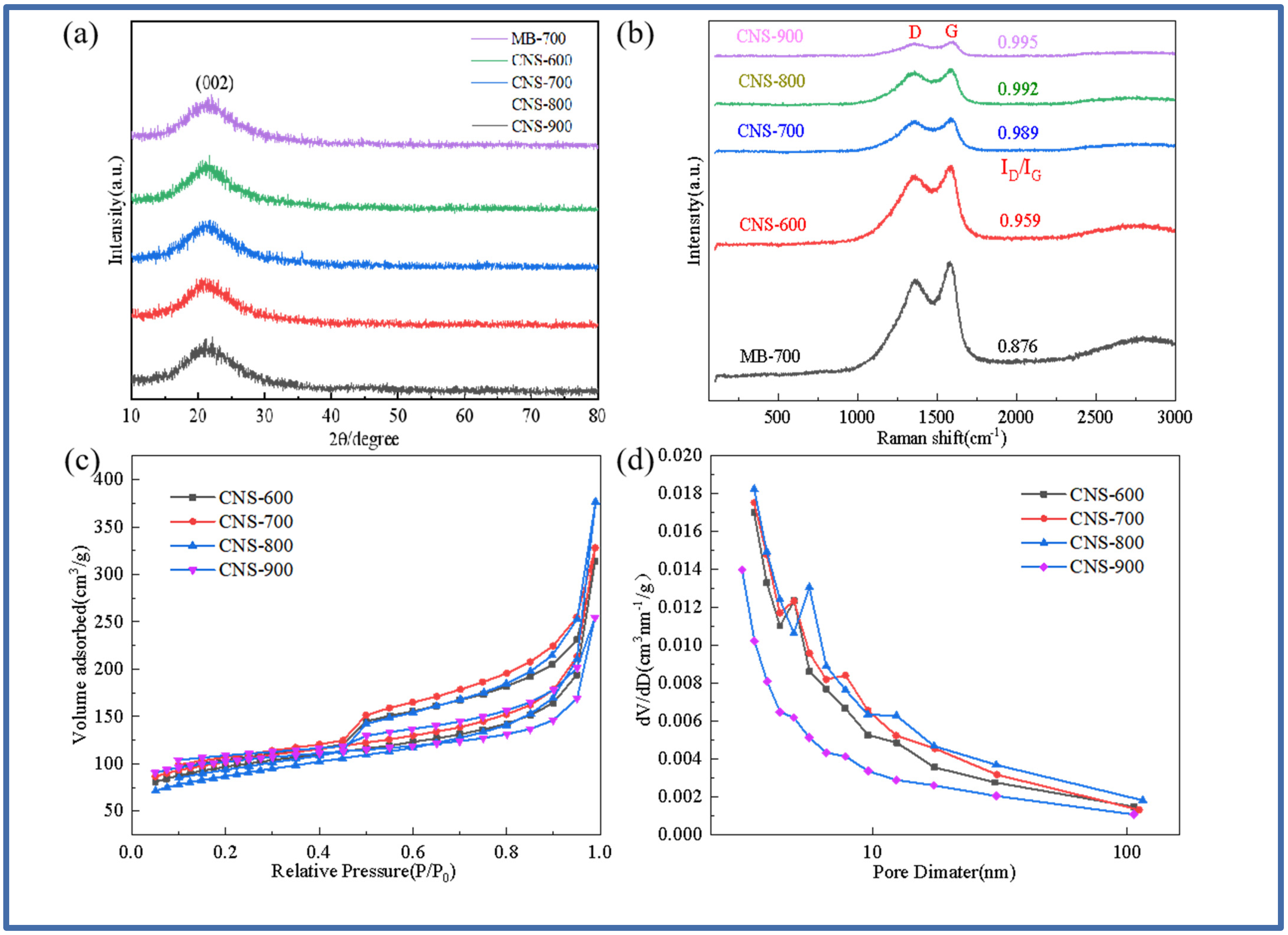


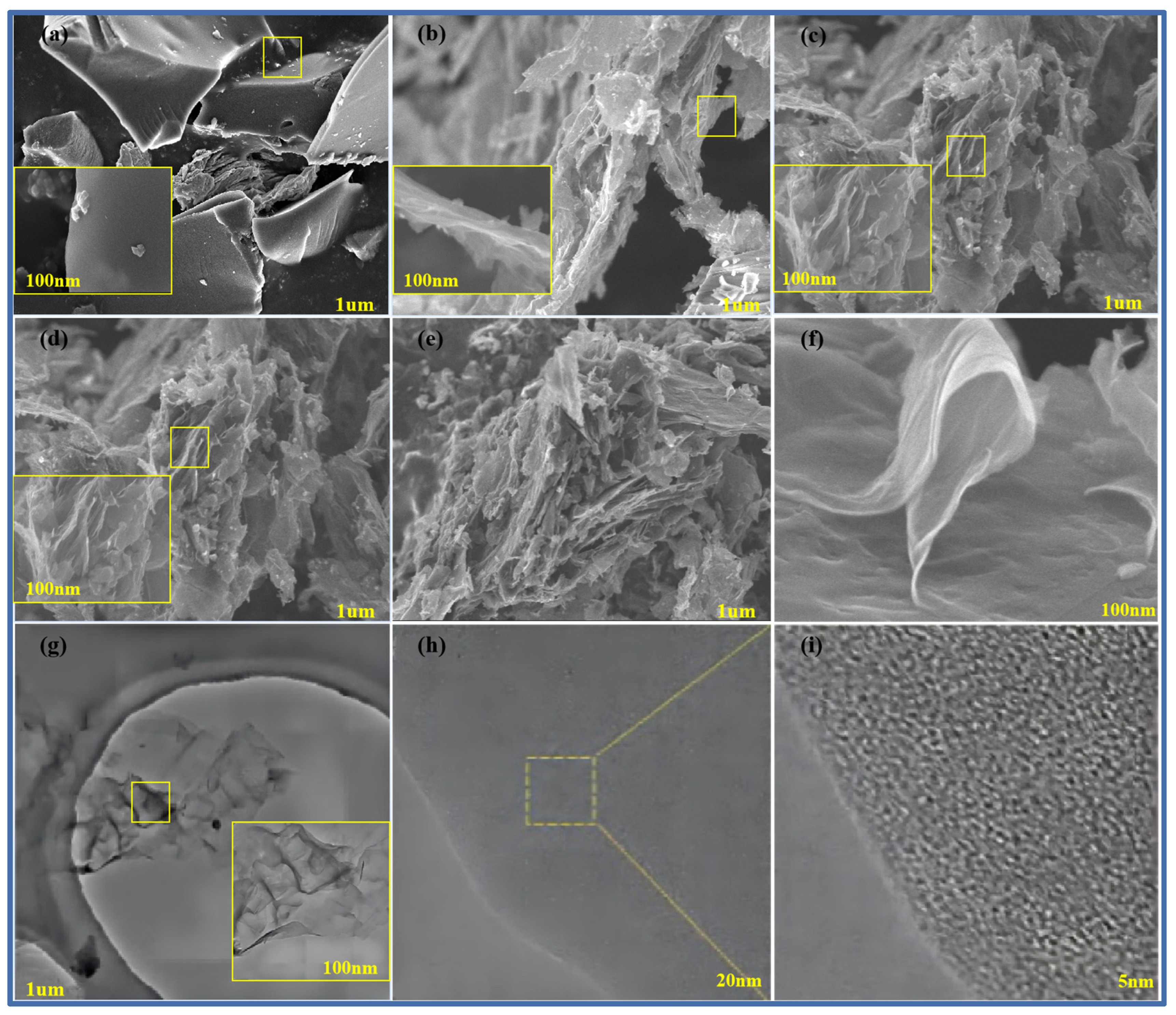

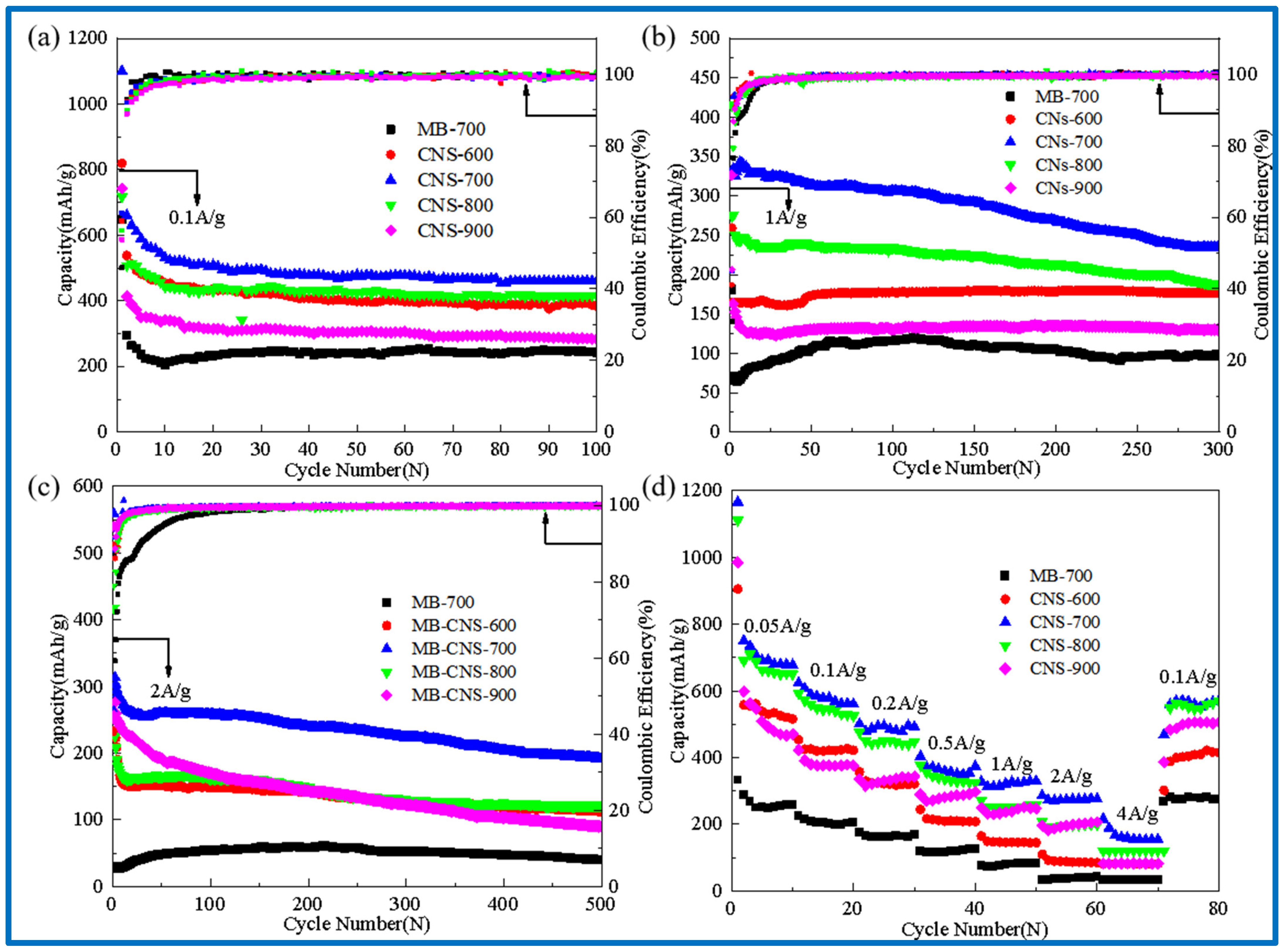
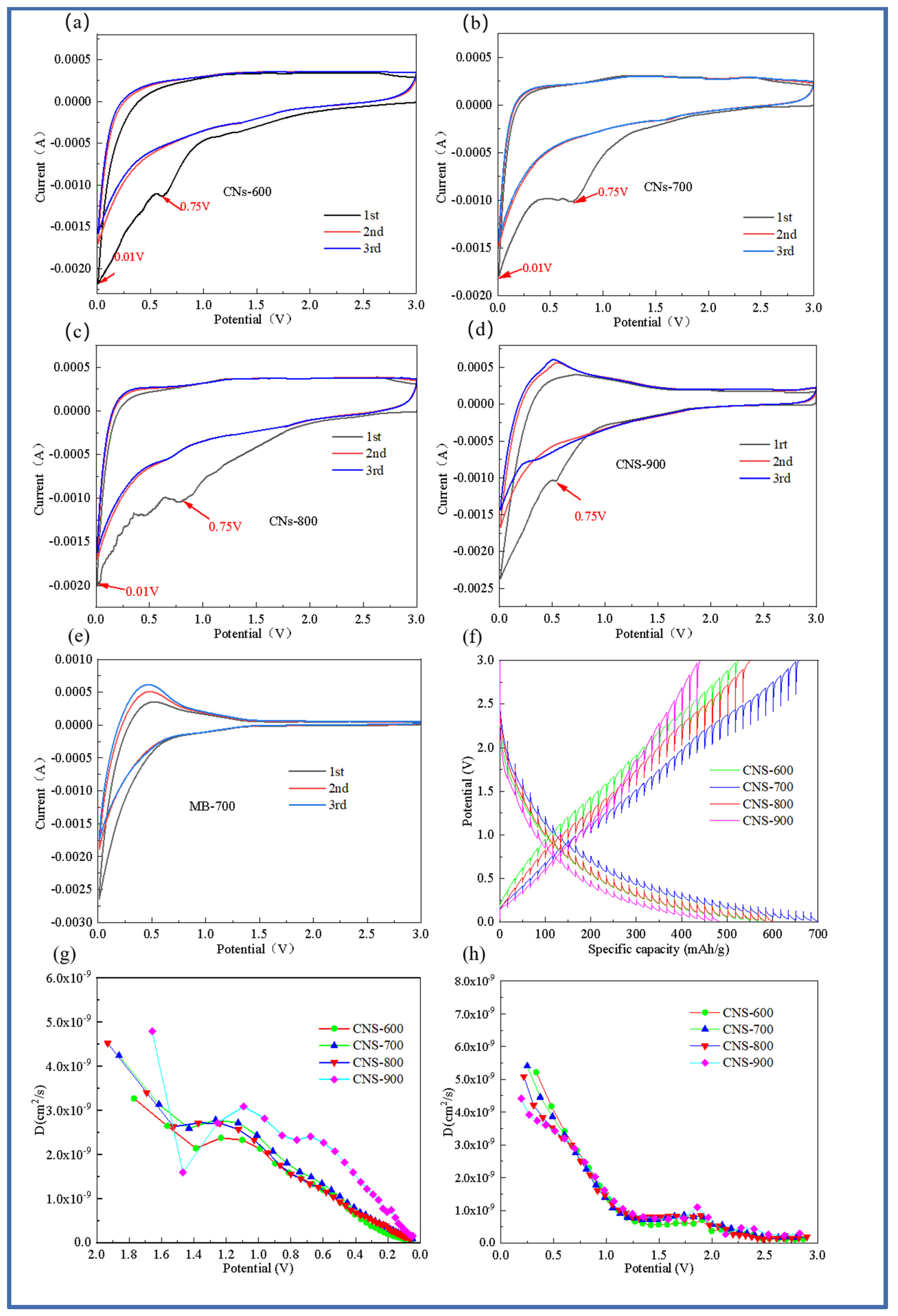
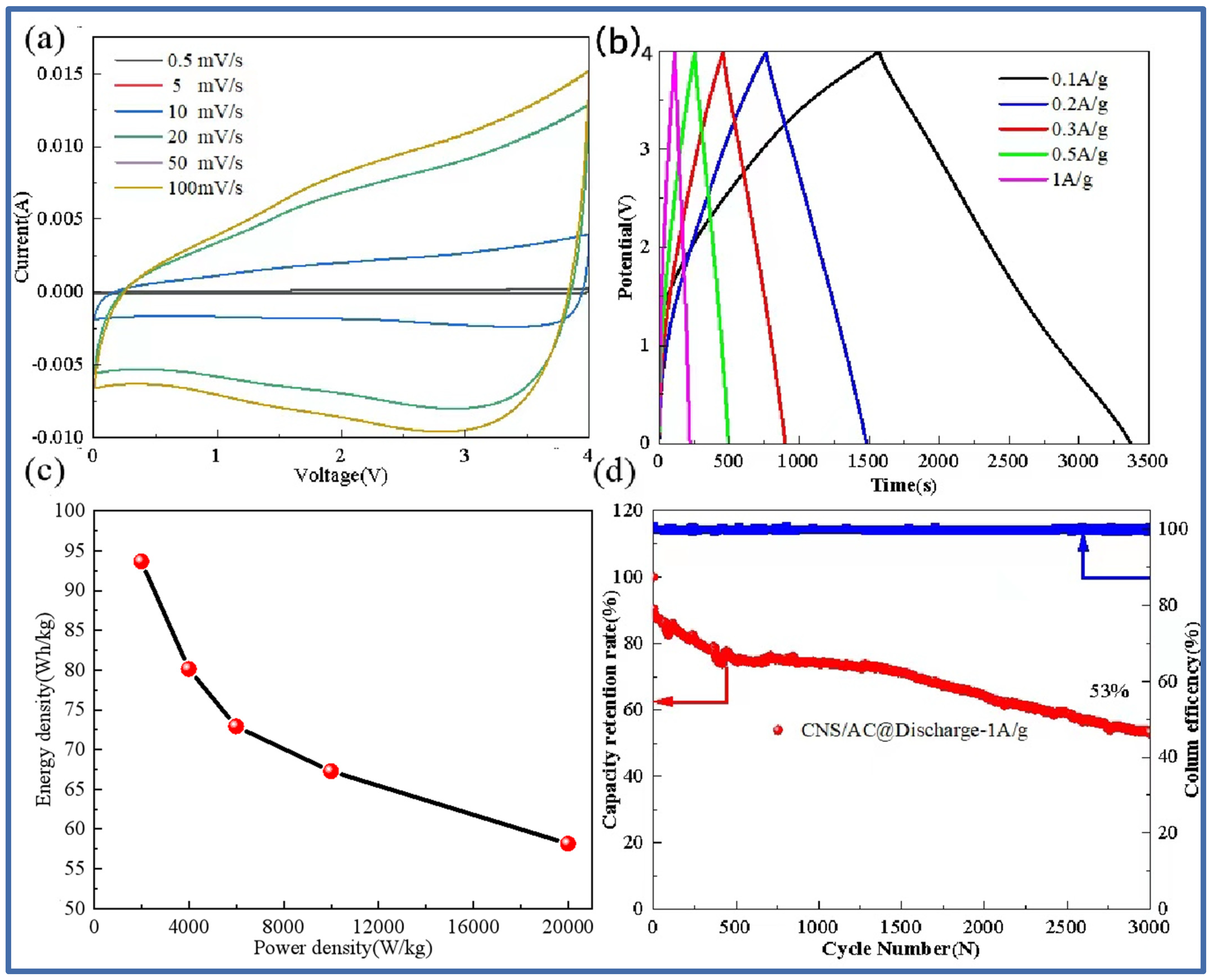
| Sample Name | Specific Surface Area (m2/g) | Hole Volume (cm3/g) | Average Pore Size (nm) |
|---|---|---|---|
| CNS-600 | 70.464 | 0.352 | 3.409 |
| CNS-700 | 84.461 | 0.369 | 3.408 |
| CNS-800 | 77.583 | 0.469 | 3.410 |
| CNS-900 | 76.332 | 0.483 | 3.441 |
| Sample Name | Fitted Value | |||
|---|---|---|---|---|
| RS/Ω | Rct/Ω | CPE/Ω−1·cm−2·s−n | W0/Ω | |
| CNS-600 | 5.49 | 33.18 | 6.22 × 10−5 | 3.57 |
| CNS-700 | 5.35 | 19.05 | 6.22 × 10−5 | 3.57 |
| CNS-800 | 8.30 | 43.66 | 6.22 × 10−5 | 3.57 |
| CNS-900 | 8.67 | 27.78 | 6.22 × 10−5 | 3.57 |
Disclaimer/Publisher’s Note: The statements, opinions and data contained in all publications are solely those of the individual author(s) and contributor(s) and not of MDPI and/or the editor(s). MDPI and/or the editor(s) disclaim responsibility for any injury to people or property resulting from any ideas, methods, instructions or products referred to in the content. |
© 2024 by the authors. Licensee MDPI, Basel, Switzerland. This article is an open access article distributed under the terms and conditions of the Creative Commons Attribution (CC BY) license (https://creativecommons.org/licenses/by/4.0/).
Share and Cite
Yang, F.; Jiang, P.; Wu, Q.; Dong, W.; Xue, M.; Zhang, Q. Preparation and Lithium-Ion Capacitance Performance of Nitrogen and Sulfur Co-Doped Carbon Nanosheets with Limited Space via the Vermiculite Template Method. Molecules 2024, 29, 536. https://doi.org/10.3390/molecules29020536
Yang F, Jiang P, Wu Q, Dong W, Xue M, Zhang Q. Preparation and Lithium-Ion Capacitance Performance of Nitrogen and Sulfur Co-Doped Carbon Nanosheets with Limited Space via the Vermiculite Template Method. Molecules. 2024; 29(2):536. https://doi.org/10.3390/molecules29020536
Chicago/Turabian StyleYang, Fang, Pingzheng Jiang, Qiqi Wu, Wei Dong, Minghu Xue, and Qiao Zhang. 2024. "Preparation and Lithium-Ion Capacitance Performance of Nitrogen and Sulfur Co-Doped Carbon Nanosheets with Limited Space via the Vermiculite Template Method" Molecules 29, no. 2: 536. https://doi.org/10.3390/molecules29020536
APA StyleYang, F., Jiang, P., Wu, Q., Dong, W., Xue, M., & Zhang, Q. (2024). Preparation and Lithium-Ion Capacitance Performance of Nitrogen and Sulfur Co-Doped Carbon Nanosheets with Limited Space via the Vermiculite Template Method. Molecules, 29(2), 536. https://doi.org/10.3390/molecules29020536







